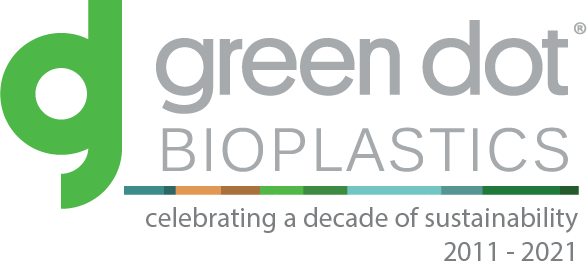Green Dot’s Terratek® Flex as an Impact Modifier for PLA
Green Dot Bioplastics finds that Terratek® Flex provides a significant increase in impact strength and elongation without compromising the compostability of PLA
Polylactic acid (PLA) is a renewable thermoplastic polyester derived from cornstarch, sugarcane or tapioca roots. The global availability of feedstocks and the (relatively) cost competitive position to petroleum-based plastics has made PLA one of the fastest growing segments in the bioplastics industry. Global markets for PLA are expected to top $5 billion by 2020; growing at an annual rate of nearly 20%. North America is the leading market for PLA with 35% of global market share. Factors contributing to the double digit growth in this segment of the bioplastics market are: rising consumer demand for biodegradable products, increasing cost competitiveness with petroleum-based plastics and the development of a wide range of additives used to enhance the physical attributes of PLA.
PLA was first introduced to consumers in food service ware and packaging because it was known to be biodegradable in an industrial composting facility. Unfortunately, the impact strength and heat tolerance of the material is quite low, making it inadequate for more demanding applications. Consumers seeking compostable products made with PLA had to settle for forks that easily broke or spoons that distorted in hot liquids. Moreover, these products and packaging materials often remained as waste because industrial composting facilities were not available to consumers. Plastic manufacturers are seeking a solution that can increase the toughness and durability of products made with PLA while enhancing the environmental benefits of compostability.
There are many commercially available materials used as impact modifiers for PLA. Rubber resin blends that contain polybutadiene and acrylic can be chemically grafted with rigid phase polymers to compatibilize the rubber in the PLA matrix. Thermoplastic urethane elastomers with both polyether and polyester soft segments are quite compatible with PLA. Olefin elastomers like polybutadiene, ethylene-propylene, and EPDM elastomers can also be functionalized and blended with PLA. Unfortunately, these materials enhance the physical properties of PLA at the cost of compostability.
Using Green Dot’s Terratek® Flex compostable elastomeric bioplastic as an impact modifier for PLA has been shown to increase impact strength and flexibility while enhancing compostability. Terratek® Flex is a proprietary patent pending starch-based compostable elastomer. It has been verified by SGS Fresenius Laboratories to meet U.S. (ASTM D6400) and E.U. (EN 13432-08) standards for biodegradability in an industrial composting facility and has been found to biodegrade in a backyard-composting environment as well. Terratek® Flex has been tested by NSF Laboratories and found to be safe from phthalates, bisphenol A, lead and cadmium.
Green Dot’s Product Development Manager, Mike Parker, studied the use of Terratek® Flex as an impact modifier for PLA.
PLA was compounded with Terratek® Flex at 10%, 20% and 30%. These samples were sent to an independent laboratory where they were molded and tested using ASTM standards.
 Notched Izod Pendulum Impact tests showed an incremental increase in impact strength at the 10% and 20% levels with greater increases in impact strength achieved between the 20% and 30% levels.
Notched Izod Pendulum Impact tests showed an incremental increase in impact strength at the 10% and 20% levels with greater increases in impact strength achieved between the 20% and 30% levels.
Impact strength increased from 0.549 ftlb/in in the 10% sample to 0.66 ftlb/in in the 20% sample. Impact strength jumped to 1.82 ftlb/in for the 30% loading level. Un-notched Izod tests showed similar results.
Tensile tests showed that strength and modulus properties declined at a proportional rate to be expected with the incorporation of an elastomer with a rigid polymer. However, elongation properties showed a similar trend to the results of the impact tests. The 10% and 20% samples showed elongation increased by 4.2% and 9.01% respectively. A more dramatic increase of 18.7% in elongation was observed at the 30% sample.
Mr. Parker summarized the results. “From 0% to 20%, the increase is very linear. After 20%, however, we see a much more exponential increase in the impact strength of both the notched and un-notched test results. Elongation properties have a similar curve. This feature allows the engineer to customize the properties of the final resin to their specifications and provides a certain degree of control to their cost to performance ratio.”
Further study is needed to provide data on the effect of Terratek® Flex on biodegradation rate of PLA. Because Terratek® Flex has been verified to meet U.S. and European standards for biodegradation in an industrial composting facility and has also been found to biodegrade in backyard composting environments, it is hypothesized that the addition of the material as an impact modifier for PLA may increase the biodegradation rate as well.
Now plastics processors can enhance the physical properties of PLA without sacrificing environmental performance, expanding the range of product applications and opening new markets for bioplastics made with PLA. Green Dot’s product development lab can quickly and effectively provide customized formulations designed to exact customer specifications. Using a pilot scale extruder, sample quantities of material can be efficiently produced for processing and testing to assure desired results.
Green Dot’s team of plastics professionals work with OEMs and plastics processors, from material selection to mold design and throughout the manufacturing process, to create products that help consumers contribute to a more sustainable world. If you would like to have a conversation about how Terratek® Flex can work for you, feel free to request a consultation with our team.
About Green Dot Bioplastics
Green Dot is a bioscience social enterprise headquartered in Cottonwood Falls, Kansas. The company serves the plastics industry and style conscious consumers with a full line of biobased and compostable materials sold under the Terratek® brand name. Green Dot aspires to improve the environment in which we live by building a more sustainable world with renewable biobased resins and promoting their use through invention, creation and research.





